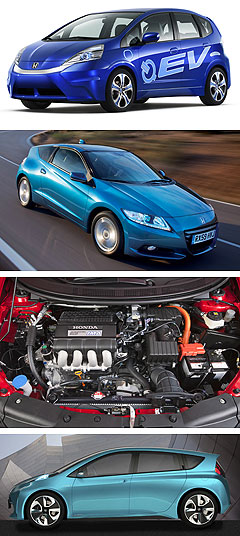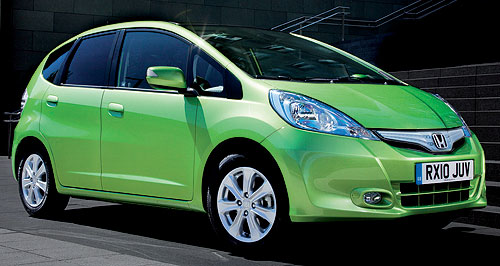Future models - Honda - Jazz - HybridAIMS: Honda upbeat for Jazz hybrid launchIf the shoe Fits: Honda’s Jazz hybrid, sold under the Fit nameplate overseas and under consideration for Australia, is capable of 3.3L/100km fuel economy. Petrol-electric Jazz on Honda Australia agenda, despite buyer resistance to hybrids4 Jul 2011 By TERRY MARTIN HONDA Australia looks set to take on Toyota’s Prius C with a hybrid version of its Jazz light car, despite senior management admitting consumers are still reluctant to commit to hybrid cars – a decade after Honda pioneered hybrid motoring in Australia with the first-generation Insight. While the first Insight was only a niche proposition, Honda has introduced mainstream hybrids with the Civic (since 2004) and second-generation Insight, the latter priced from an industry-leading $29,990 but averaging only 55 sales a month to the end of May this year – well down on the 200 a month forecast at its launch last November. Honda will also launch the all-new sporty CR-Z hybrid in November and, while not committing to a price point – expected to be around $35,000 – senior director Lindsay Smalley revealed the company’s initial sales volume aspirations were only around 60 to 70 cars a month. However, Mr Smalley said the company was committed to introducing more hybrid models, including the Jazz hybrid if it was made available to this market. Asked specifically about the Jazz hybrid at the Australian International Motor Show in Melbourne last Friday, he said: “We will have a full range of hybrids over the next couple of years, definitely. Whatever’s available we’ll take.”  From top: Honda Jazz EV, Honda CR-Z, Toyota Prius C concept. From top: Honda Jazz EV, Honda CR-Z, Toyota Prius C concept.Using the same Integrated Motor Assist (IMA) petrol-electric drive system as the Insight, the Jazz hybrid combines a 65kW/121Nm 1.3-litre i-VTEC engine with a 10kW/78Nm electric motor (for total outputs of 75kW and 199Nm), driving the front wheels through a CVT transmission and offering outstanding fuel economy of just 3.3L/100km. Its CO2 emissions are also extremely low at 77g/km. Mr Smalley said the full electric version of the Jazz, which was shown in near-production concept form at the Geneva motor show in March, was not on the agenda for Australia and “highly unlikely” to be sold here. “My personal view is that EV has very, very limited application in a market like Australia,” he said, pointing to issues such as travel distances. “(Jazz) hybrid gives you much more flexibility from a distance point of view, not running out of battery power halfway down the Monash Freeway or in the Burnley Tunnel. “Any solution for that type of transport needs to have some flexibility, and if it’s locked in to a finite battery charge period, I don’t see that having sufficient flexibility within the context of our market.” Although the company is committed to launching new hybrid models, Mr Smalley identified a number of issues with hybrids that were restricting sales, including vehicle price, battery longevity and resale value. “A lot of consumers essentially say they’ll buy hybrid, but when it comes down to paying a premium for hybrid technology there is resistance on price, there is resistance on battery life – even though we’ve got an eight-year fully warranted battery in the car, so battery is an issue for people – and resale is an issue for people,” he said. “So we need to overcome those elements to really get hybrid (sales) working properly in this market. “At the moment, the (hybrid) market is certainly in its infancy in Australia, and ... the thinking on new technologies seems to be very, very strong from a (consumer) electronics point of view, but when it comes down to motoring, there is a great resistance to move away from traditional motor arrangements. “We were very optimistic with Insight and we thought with the pricing and that product that we would break through the hybrid barrier. And we have not achieved that.” Mr Smalley described the CR-Z as “another step on the way” to breaking down the hybrid sales barrier and, although he promised it would be “highly competitive”, he admitted that early demand was not expected to be high. “We are going to start with quite a conservative outlook on the car because there is resistance to hybrid technology, so in the first few months we’ll be bringing in maybe 60 or 70 a month from the factory.” Mr Smalley said the vehicle had the potential to “snap a change in attitude toward hybrid” and that the company should have the ability to increase supply if required. The Jazz EV will use a lithium-ion battery and a high-density coaxial electric motor derived from its FCX Clarity fuel cell vehicle. The company claims the light EV will have a top speed of 145km/h and an estimated driving range of 160km, based on the US EPA LA4 city cycle (or 112km with the EPA’s adjustment factor applied). It will also have three driving modes adapted from the CR-Z which allows the driver to switch between normal, economy and sport settings to either maximise efficiency or improve acceleration. Honda claims the ‘Econ’ mode can increase the ‘practical’ driving range by as much as 17 per cent compared to the normal mode, or by 25 per cent compared to driving in Sport – a mode that is said to generate performance “similar to a vehicle equipped with a 2.0-litre petrol engine”. Battery recharging is claimed to take less than six hours when using a 240-volt power outlet, or around twice that long when using a 120-volt supply.  Read more27th of June 2011  AIMS: Toyota confirms city PriusThrifty Toyota Prius C to set new hybrid benchmark when it arrives in 201214th of February 2011  Geneva show: Honda gets Jazzy with EVHonda electric car concept points the way to full production 2012 Jazz EV28th of September 2010  Paris show: Honda Jazz hybrid eco detailsHonda’s light hybrid emerges in a lighter shade of green ahead of Paris premiereAll future models Alfa Romeo Alfa Romeo Abarth Abarth Alpine Alpine Alpina Alpina Audi Audi Aston Martin Aston Martin BMW BMW Bentley Bentley Chery Chery Brabham Brabham Chrysler Chrysler Chevrolet Chevrolet Cupra Cupra Citroen Citroen DS DS Dodge Dodge Fiat Fiat Ferrari Ferrari Foton Foton Ford Ford Great Wall Great Wall FPV FPV Haval Haval GWM GWM Honda Honda Holden Holden Hummer Hummer HSV HSV Infiniti Infiniti Hyundai Hyundai Jaguar Jaguar Isuzu Isuzu Kia Kia Jeep Jeep Land Rover Land Rover Lamborghini Lamborghini Lexus Lexus LDV LDV Mahindra Mahindra Lotus Lotus Mazda Mazda Maserati Maserati Mercedes-AMG Mercedes-AMG McLaren McLaren MG MG Mercedes-Benz Mercedes-Benz Mitsubishi Mitsubishi Mini Mini Opel Opel Nissan Nissan Peugeot Peugeot Pagani Pagani Proton Proton Porsche Porsche Renault Renault Ram Ram Rover Rover Rolls-Royce Rolls-Royce Skoda Skoda Saab Saab SsangYong SsangYong Smart Smart Suzuki Suzuki Subaru Subaru Toyota Toyota Tesla Tesla Volvo VolvoJazz pricingMotor industry news |
Click to shareHonda modelsResearch Honda All future models Alfa Romeo Alfa Romeo Abarth Abarth Alpine Alpine Alpina Alpina Audi Audi Aston Martin Aston Martin BMW BMW Bentley Bentley Chery Chery Brabham Brabham Chrysler Chrysler Chevrolet Chevrolet Cupra Cupra Citroen Citroen DS DS Dodge Dodge Fiat Fiat Ferrari Ferrari Foton Foton Ford Ford Great Wall Great Wall FPV FPV Haval Haval GWM GWM Honda Honda Holden Holden Hummer Hummer HSV HSV Infiniti Infiniti Hyundai Hyundai Jaguar Jaguar Isuzu Isuzu Kia Kia Jeep Jeep Land Rover Land Rover Lamborghini Lamborghini Lexus Lexus LDV LDV Mahindra Mahindra Lotus Lotus Mazda Mazda Maserati Maserati Mercedes-AMG Mercedes-AMG McLaren McLaren MG MG Mercedes-Benz Mercedes-Benz Mitsubishi Mitsubishi Mini Mini Opel Opel Nissan Nissan Peugeot Peugeot Pagani Pagani Proton Proton Porsche Porsche Renault Renault Ram Ram Rover Rover Rolls-Royce Rolls-Royce Skoda Skoda Saab Saab SsangYong SsangYong Smart Smart Suzuki Suzuki Subaru Subaru Toyota Toyota Tesla Tesla Volvo VolvoJazz pricingMotor industry news |
















Facebook Twitter Instagram